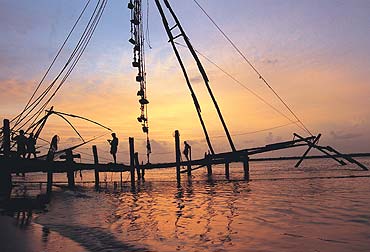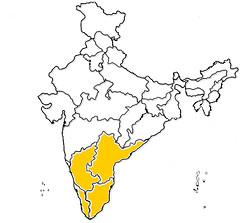Ilankai Tamil Sangam30th Year on the Web Association of Tamils of Sri Lanka in the USA |
|||
 Home Home Archives Archives |
The Better Halfby Ramachandra Guha, Outlook India, July 16, 2007
Historically open to the outsider, and inclusive within, the south's emerged denominator on top A Harvard historian once wrote a book explaining how the northern parts of a country always developed first and fastest. He based his thesis, as Harvard historians tend to do, on the nations of the Atlantic world. He went over the list one by one: Italy, Germany, England, and the United States. In these (and other) countries, the north had led the way in technical innovation, economic growth, political emancipation, and social reform. The differences between north and south were so extreme that sometimes—as in the United States—they even led to civil war. For it now appears that by most indicators of development, the south of India is comfortably ahead of the north. According to one study published in 2005, the per capita income of the southern states, taken together, was 50 per cent higher than the states of the north. At 74 percent, the literacy rate in the south was well in excess of the north's 59 per cent. As many as 74 per cent of southern households had electricity, compared to a mere 49 per cent in the north. The south's superiority might be demonstrated in qualitative ways as well: in the relative absence of communal violence, for example, or the greater emancipation of women. That the south of India is more advanced than the north is now part of the conventional wisdom. As it happens, I am just about old enough to recall a time when the terms 'Madrasi' and 'South of the Vindhyas' denoted derision and scorn. The typical North Indian regarded the typical South Indian as short, squat, black, effete—and vegetarian. But now, those once proud people are voting with their feet to move south. They come to write code in Bangalore's software companies, to labour on construction sites in Hyderabad, to work in coffee plantations in Coorg, or to do odds and ends in Chennai's film industry. Now, the stereotype of the South Indian among Punjabis and Biharis is that he is intelligent, hardworking, entrepreneurial, and open-minded. And that he can very often be a she. And, most importantly, that if you study well and behave yourself, she or he can give you a job. One striking difference between north and south India relates to how they have viewed people from far away. The foreigner came to the north as a marauder and conqueror; to the south, as a traveller and trader. This is as much true of 'foreign' religions as it is of foreign individuals. There were Christians in Kerala several centuries before there were Christians in Europe. Unlike their northern counterparts, the Moplah Muslims of Malabar speak Malayalam, not Urdu—besides, no one can accuse them of an identification with invaders or interlopers. That the region has such an active coastline has of course contributed to this openness. Human communities who live along the sea are generally more curious and less insular than the inhabitants of deserts and mountains. People have come and gone down the centuries to and from the ports along the southern coasts, bringing or receiving new ideas, goods, and technologies. The south enjoys geographical advantages in the hinterland as well. The topography and climate of the Deccan Plateau are congenial to human settlement and transportation. There is no Himalaya, and no Thar Desert either. In what are now the contiguous states of Andhra Pradesh, Karnataka and Tamil Nadu, individuals and communities could very easily shift from one village or town to another, hundreds of miles distant. This process of movement and migration led to a deep intermingling of castes, religions and—not least—linguistic groups. Indeed, one reason for the south's current superiority, such as it is, has to do with the fact that it has historically been multilingual. Because the region has a long coast, and because its terrain is so easy to walk across, the towns of south India have for a very long while had speakers of many languages dwelling within them. Bangalore, for example, is the only city in the world that has daily film shows in as many as six languages (the four southern tongues, as well as English and Hindi). Chennai has a million or more Telugu speakers. This linguistic pluralism is also manifest in the smaller towns of the region; so, whereas in Ludhiana you will hear only Punjabi and Hindi, in Coimbatore you will hear the six languages spoken in Bangalore, and Marathi as well. That the residents of the four southern states are, on the whole, less bigoted and more forward-looking is a product not of their genes but of their environment. Over hundreds of years, they have learnt to live with people speaking different tongues or professing a different faith. At the same time, they have also learnt to be less discriminatory among themselves. Women in the south are less likely to be manhandled in a bus or train; they are also more likely to practise law or medicine, or run a business. This too has something to do with history and geography. Women's work is more crucial to (and hence more greatly valued in) rice as compared to wheat cultivation. Among some communities in south India, property was inherited through the female line. And, with no Rajputs or Mughals around as role models, there was little pressure to put women in purdah. The comparative social egalitarianism of the south has other reasons and manifestations. Historically, there were fewer large zamindars than in the north and east; thus, many more peasants owned the land they tilled. The challenge to the caste system is more ancient and more robust than in the north. Medieval poets and reformers attacked the hegemony of the Brahmins; as, in the colonial period, did such men as Iyothee Thass and E.V. Ramaswami. Since they have historically been more open to outsiders, as well as more inclusive within, the south has taken full advantage of the new global economy. Bangalore and Chennai have recently welcomed Frenchmen and Koreans as they once opened their gates to, respectively, Tamils and Andhras. In this part of India, history and mythology do not demand of Hindu youths that they set off, trishul in hand, in search of Christian priests or Muslim rickshaw-pullers. Those of different religions and none, men as well as women, high caste and low caste and obc, are all more intent on making a living than on fighting along the lines of identity. With a generally tolerant and peacable citizenry, investors need not fear that their factories will go up in flames. With a workforce that is disciplined as well as efficient, they can sit back, relax, and watch the numbers stack up. To my knowledge, the first writer to see the southern surge coming was the Australian diplomat Walter Crocker. In his biography of Jawaharlal Nehru, published in 1966, Crocker observed that "south India has counted for too little in the Indian Republic. This is a waste for India as well as an unfairness to south India, because the south has a superiority in certain important things—its relative lack of violence, its lack of anti-Muslim intolerance, its lack of indiscipline and delinquency in the universities; in its better educational standards, its better government, and its cleanliness; in its far lesser practice of corruption and its little taste for Hindu revivalism. If the English language is to be saved to India as a living language it is the south that will save it". Crocker's verdict is now widely endorsed. As an Indian of Tamil extraction who counts Bangalore as his hometown, I suppose I should take some pride in this. But as a historian I know only too well that in the history of humankind there are no permanent winners and losers. As I write, Hindu revivalists are, for the first time, in power in Karnataka. Successive governments in Tamil Nadu have been as corrupt as any in Uttar Pradesh or Haryana. Violence is endemic in Andhra Pradesh; practised with varying degrees of brutality by upper-caste landlords, mining magnates, religious fanatics, and Naxalites. The indiscipline and delinquency of the Malayalees has scared away investors both Indian and foreign. And there are deep divisions between town and country. There is a fabulous amount of wealth being generated in Bangalore and Hyderabad; travel an hour out of either city, and the faces one sees speak of a quiet desperation. Southern complacency would be out of place, if only because nations once led by their northern halves have more recently witnessed a reversal of fortunes. It is the south of England that is rich and resurgent; the old northern towns of Manchester and Sheffield have become industrial graveyards. In the United States, the dash and elan of Atlanta and Dallas are in striking contrast to the demoralisation of Detroit and Pittsburgh. Who knows: a few decades down the line, perhaps historians will be asked to explain why Bihar is so much more prosperous and peaceful than Tamil Nadu. (Ramachandra Guha is the author of India After Gandhi.) |
||
|
|||
 I think it unlikely that the scholar had much acquaintance with the Republic of India, a land that has a long-standing—and well deserved—reputation for upturning the hypotheses of academic social science.
I think it unlikely that the scholar had much acquaintance with the Republic of India, a land that has a long-standing—and well deserved—reputation for upturning the hypotheses of academic social science.  Why is the south 'superior'? Why, when compared to other parts of India, does it attract more investment and appear to be more socially benign? To answer this question one needs to invoke both history and geography, sometimes acting singly, at other times in combination.
Why is the south 'superior'? Why, when compared to other parts of India, does it attract more investment and appear to be more socially benign? To answer this question one needs to invoke both history and geography, sometimes acting singly, at other times in combination.